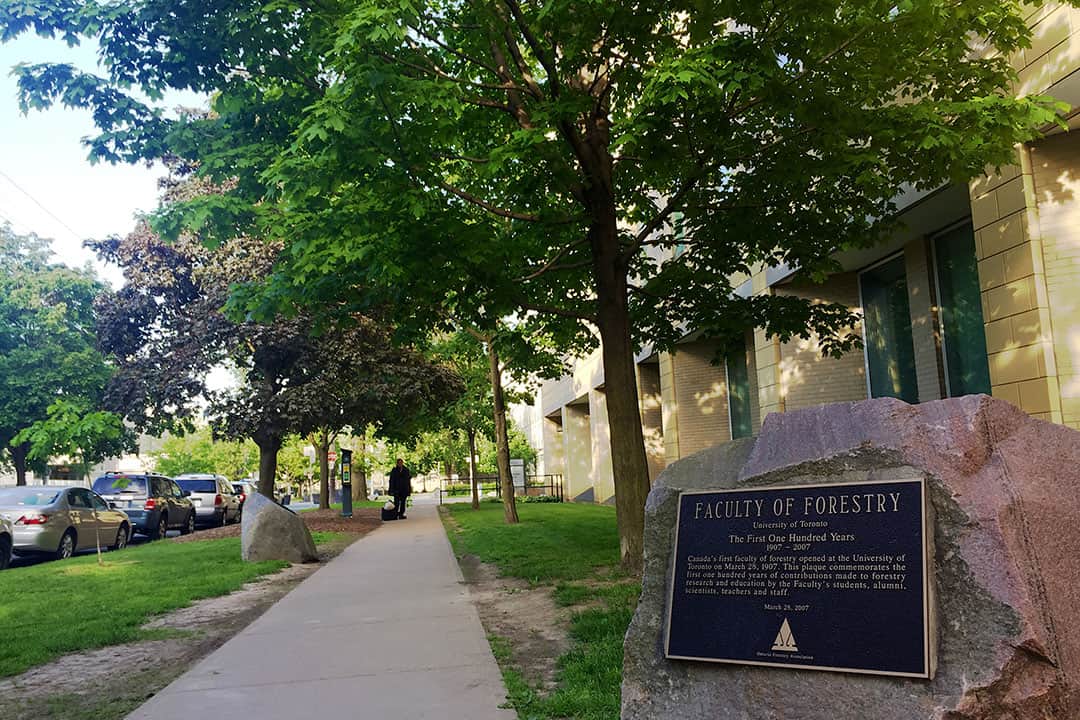In its final meeting of 2018–2019, Governing Council approved a proposal to disestablish U of T’s Faculty of Forestry and restructure it as a graduate unit under the John H. Daniels Faculty of Architecture, Landscape, and Design. Following a discussion period, which included statements of opposition from the Forestry Graduate Students’ Association (FGSA) and the University of Toronto Students’ Union (UTSU), the proposal received 29 votes in favour and two abstentions.
On July 1, the 112-year-old faculty, which was Canada’s first for forestry-related studies, closed. Forestry’s faculty budgetary appointments will transfer to Daniels. U of T will add an additional $1 million to Daniels’ annual base budget and provide supplementary resources to hire five additional faculty members for Forestry, doubling its current number.
The proposal does not outline any changes to either Daniels or Forestry programs. Forestry’s three programs — the Master of Forestry Conservation, the Master of Science in Forestry, and the PhD in Forestry — will all continue to operate. Forestry will remain located in the Earth Sciences Centre on 33 Willcocks Street.
Forestry-specific endowments and graduate funding will remain, as will the FGSA as a representative for Forestry students.
Genesis of the proposal
Current Forestry Dean Robert Wright, who was hired in 2017 with the intention of advancing Forestry’s restructuring, ended his term on June 30, after the Dean of Forestry position ceased to exist.
Daniels Dean Richard Sommer will appoint a Forestry Program Director from Forestry’s five current tenure-stream faculty members. The Program Director will oversee Forestry programs’ day-to-day operations while Sommer will maintain administrative and budgetary responsibility for Forestry in addition to his current responsibilities.
U of T hopes that restructuring the Faculty of Forestry under Daniels will provide Forestry programs with greater academic and financial stability. In 2018–2019, Forestry had 122 students and an attributed operating revenue of around $3.68 million — the third-smallest of U of T’s 20 divisions. In comparison, in 2018–2019, Daniels had an attributed operating revenue of approximately $36.29 million, as well as 27 tenure-stream faculty members and 1,468 students.
The proposal cites Forestry’s low enrolment, faculty complement, and current demand as indicators that it is not financially sustainable in its previous form.
Student opposition
At the meeting, FGSA Chair Nicole Tratnik criticized the university’s perceived failure to provide a suitable academic rationale or an academic framework to ensure that Forestry’s identity will be maintained under Daniels.
“We are concerned that the restructuring will turn this multi-faceted faculty into only urban forestry and wood engineering sub-programs,” she said.
She reiterated the FGSA’s demand to establish Forestry as a higher-level Extra-Departmental Unit (EDU) within Daniels. “This will keep Forestry’s science- and lab-based interests intact and visible under a design- and studio-based Faculty,” she said.
UTSU Vice-President Professional Faculties Dermot O’Halloran also addressed the council and urged its members to delay the proposal’s approval until further consultations with students are made. “At the very least, institutional protections for students in Forestry, such as creating an EDU:A or :B, should absolutely not be taken off the table,” he said. “We see and recognize the value of the Faculty of Forestry as it stands and we ask that you do today as well.”
In response to these concerns and questions brought up by members of the council, Wright advocated for the proposal’s merits. He described Forestry’s current faculty structure as “the most expensive form of administrative activity.”
“As an academic, my obligation is to protect the programs,” he said. “If you really want to save the Forestry programs, now’s the time to actually do it because this [restructuring] will… revolutionize the capacity of Forestry.”
Forestry’s future
The FGSA’s demands for Forestry to be demarcated as an EDU have thus far been delayed by the university and Daniels, who have said that such discussions could be had if and when Forestry is restructured. Now that the restructuring has been approved, Tratnik said that the FGSA remains hopeful of progress given Daniels’ “experience incorporating new programs into their Faculty.”
“Foresters think about managing forests not only for now, but for the next several decades. We feel that restructuring the Faculty of Forestry should [be] thought of in a similar way,” Tratnik told The Varsity. “Our goal has always been to ensure that the standard of forestry education remains for students in the future.”
The Governing Council vote on June 25 was the proposal’s final stage of formal governance. It was unanimously recommended by the Planning and Budget Committee on May 9. The proposal then received 43 votes in favour, three votes against, and two abstentions at the Academic Board on May 30. The Executive Committee endorsed and forwarded the proposal on June 10.


